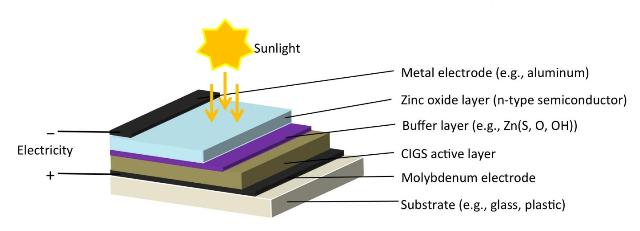The structure of a zinc-based buffer layer in a copper-indium-gallium-selenide (CIGS) solar cell has been determined. Knowing the buffer layer's structure has allowed the research team to identify a method of increasing solar cell efficiency.
 This image shows the configuration of a typical CIGS solar cell. Credit: COPYRIGHT (C) 2015 TOYOHASHI UNIVERSITY OF TECHNOLOGY. ALL RIGHTS RESERVED.
This image shows the configuration of a typical CIGS solar cell. Credit: COPYRIGHT (C) 2015 TOYOHASHI UNIVERSITY OF TECHNOLOGY. ALL RIGHTS RESERVED.
CIGS solar cells are compound thin-film solar cells and are an ideal substitute for silicon solar cells. In recently conducted tests CIGS solar cells achieved a solar conversion efficiency of more than 20%. Whilst it had been observed that the buffer layer greatly influences the conversion efficiency the structure of the buffer layer and how it influences the solar cell conversion efficiency had not yet been determined.
Performing structural analysis on very thin films is extremely difficult
- Professor Mansanobu Izaki, Toyohashi University of Technology
Researchers from the Toyohashi University of Technology, the Research Center for Photovoltaic Technologies and the National Institute of Advanced Industrial Science and Technology have all contributed to the study which was conducted at SPring8, the largest third-generation synchrotron radiation facility in the world. The collaborative research team were able to successfully determine the buffer layer structure and identify a method to enhance the conversion efficiency.
We analyzed the structure of the buffer layer by X-ray photoelectron spectroscopy, transmission electron microscopy, and other techniques. We found that the buffer layer was composed of two layers: an upper Zn(OH)2 layer and a lower Zn(S, O) layer. Moreover, the conversion efficiency was improved from 6.8% to 13.7% by removing the upper Zn(OH)2 layer
- Professor Mansanobu Izaki, Toyohashi University of Technology
The team has demonstrated a simple yet robust method to remove the upper Zn(OH)2 layer by immersion of the film in ammonia. Using this method the researchers were able to double the conversion efficiency of the solar cell.
Th research displays the significance of the structure and composition of the buffer layer and forms a crucial stepping stone towards the development of advanced CIGS solar cells. It is predicted that once CIGS solar cells can be economically mass produced they will become main players in the solar cell market.